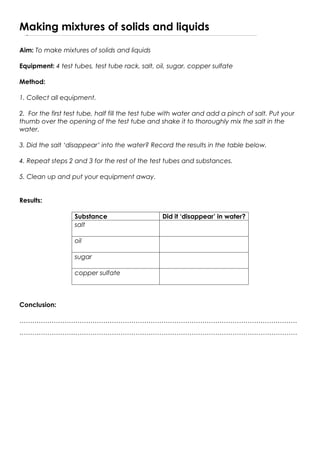Making mixtures of solids and liquids
•Als DOC, PDF herunterladen•
0 gefällt mir•2,873 views
Melden
Teilen
Melden
Teilen

Empfohlen
Empfohlen
Weitere ähnliche Inhalte
Was ist angesagt?
Was ist angesagt? (11)
Andere mochten auch
Andere mochten auch (10)
Writing a WHY paragraph- "Go back to where you came from" documentary

Writing a WHY paragraph- "Go back to where you came from" documentary
Ähnlich wie Making mixtures of solids and liquids
Ähnlich wie Making mixtures of solids and liquids (20)
Dacota_blue K12: Science 7: Quarter 1: Module 1 matter

Dacota_blue K12: Science 7: Quarter 1: Module 1 matter
Mehr von alice_leung
Mehr von alice_leung (20)
Separation techniques by Nikhar, Andrew, Kushal, Tyler, Aaron and Shehan

Separation techniques by Nikhar, Andrew, Kushal, Tyler, Aaron and Shehan
Level up! Games based learning at Merrylands High School

Level up! Games based learning at Merrylands High School
Making mixtures of solids and liquids
- 1. Making mixtures of solids and liquids Aim: To make mixtures of solids and liquids Equipment: 4 test tubes, test tube rack, salt, oil, sugar, copper sulfate Method: 1. Collect all equipment. 2. For the first test tube, half fill the test tube with water and add a pinch of salt. Put your thumb over the opening of the test tube and shake it to thoroughly mix the salt in the water. 3. Did the salt ‘disappear’ into the water? Record the results in the table below. 4. Repeat steps 2 and 3 for the rest of the test tubes and substances. 5. Clean up and put your equipment away. Results: Substance Did it ‘disappear’ in water? salt oil sugar copper sulfate Conclusion: ………………………………………………………………………………………………………………… …………………………………………………………………………………………………………………
- 2. Solutions, solutes and solvents When a solid ‘disappears’ into a liquid, we say the solid has dissolved into the liquid. The solid that does the ‘disappearing’ is called the solute and the liquid is called the solvent. A mixture of a solute and a solvent is called a solution. If the solid doesn’t dissolve into the liquid, the mixture is called a suspension. Here is your results table again. This time you need to identify the solute and the solvent. Substance Did it dissolve What is the What is the Is this mixture in water? solute? solvent? a solution or a suspension? salt flour copper sulfate sand sugar Complete these sentences When a solid ‘disappears’ into a liquid, the solid has …………………… When a solid dissolves into a liquid the mixture is called a ………………………………… When a solid doesn’t dissolve into a liquid the mixture is called a ………………………… In a solution, the solid that has dissolved is called the ………………………….. In a solution, the liquid that dissolves the solid is called the …………………………